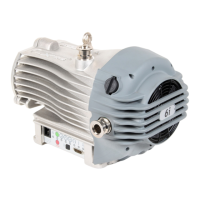© Edwards Limited 2017. All rights reserved. Page 17
Edwards and the Edwards logo are trademarks of Edwards Limited.
Installation
A735-01-880 Issue C
3.3 Unpack and inspect
Remove all packing materials, remove the pump from its packing box, remove the protective covers from the inlet
and outlet ports and inspect the pump. If the pump is damaged, notify the supplier and carrier in writing; state the
item number of the pump together with the order number and supplier's invoice number. Retain all the packing
materials for inspection. Do not use the pump if it is damaged. If the pump is not to be used immediately, replace
the protective covers. Store the pump in suitable conditions, as described in Section 6.1. Refer to Section 6.2 for
disposal of materials.
3.4 Position the pump
Provide a firm, level platform for the pump. Locate the pump so that the gas ballast control and the user controls
are accessible.
If the pump will be located inside an enclosure, ensure that there is adequate ventilation at both ends of the pump,
so that the ambient temperature around the pump does not exceed 40 °C. There must be a minimum space of 25 mm
between the pump and the enclosure walls.
3.4.1 Mechanical fixing
Note: The pump can be secured by using the four holes located on each corner of the pump base. Edwards
recommends using M8 bolts.
3.5 Connect to the vacuum system
Refer to Figure 1. Before connecting the pump to the vacuum system, remove the plastic cap from the inlet and
exhaust, and ensure that the inlet strainer is fitted to the pump inlet port. Use appropriate NW25 vacuum fittings for
connection to the system.
Use suitable lifting equipment to move the nXDS pump. The maximum pump mass is 27 kg.
Mechanical lifting equipment should be attached to the lifting eye; loose slings should not
be used.
Take care when moving the pump into position. Its mass may make it difficult to slide. The
fan cowl is shaped to provide a handhold for positioning; the pump must not be lifted using
this handhold.
If the pump is to be used on the floor of a work area, position the power lead and the exhaust and
inlet hoses with care. Ensure that personnel in the area are aware of any obstructions around the
pump.
If pumping dangerous gases or vapours, connect the exhaust to a suitable treatment plant to
prevent the discharge of dangerous gases and vapours to the surrounding atmosphere.
If the pump is operated with the exhaust line blocked, high pressure may be generated in the
exhaust line pipework.

